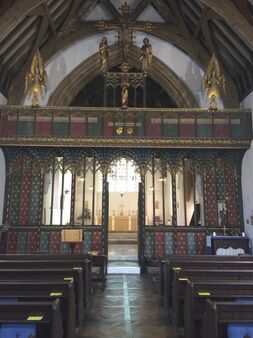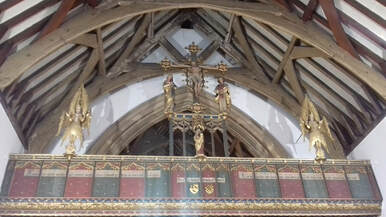The Comper Rood Screen
|
The Rood Screen, commissioned for St Peter's Church by The Revd Salisbury Price during his second curacy at Holy Trinity Church in Ely, is claimed on good authority to be the earliest major work of Sir John Ninian Comper (1864-1960). Comper was a trained architect working in London in partnership with his brother-in-law and it was in the early 1890s that the St Peter's Screen was designed.
|
The carving and general preparation of the screen was done in London and sent down to Ely in sections to be assembled and painted in position, a task which took more than three months. The arches of the screen support a gallery six feet wide and a Rood, whilst the under part of the gallery is lavishly carved, richly gilded and painted. The panels of the screen are decorated with stylised flowers, probably daisies and cornflowers, the flowers of Paradise.
Over the central doors are two shields bearing the arms of the two families - the Sparke and Upcher families - who were generous in their gifts to the church. (The Sparkes' only daughter married a member of the Upcher family) |
A Latin inscription over the shields above the central doors reads:
OREMUS HUIUSCE PRO BENEFACTORIBUS CAPELLAE
Let us pray for the Benefactors of this Chapel
OREMUS HUIUSCE PRO BENEFACTORIBUS CAPELLAE
Let us pray for the Benefactors of this Chapel
(The following notes were provided by Canon Chris Barber in 2007)
On this screen, a treasure of St. Peter’s Church and one of the first-fruits of the special genius of J N Comper, are two Latin sentences with musical notation which have been a mystery to local historians up till now. I am pleased to be able to explain the mystery and to thank The Revd Fr Nigel Hancock for his researches in the University Library, Cambridge which has made it possible to do so.
|
Comper was deeply aware of the liturgical significance of his designs and very knowledgeable about their historical context so it is not surprising that in designing a chancel screen with the traditional rood-cross and its supporters, St. Mary and St. John, that he should incorporate the liturgical texts appropriate for the veneration of Christ's Cross.
These appear on the left and right halves of the screen as you look at it eastwards from the nave and are both antiphons (or “theme-verses”) to be sung before and after two psalms provided for the Feast of the Exaltation of the Holy Cross according to the Sarum use. |
The Feast of the Exaltation of the Cross, often known as “Holy Cross Day”, falls on 14th September and commemorates “the exposition of the supposed true cross by the Emperor Heraclius, after his recovery of it from the Persians into whose hands it had fallen in 614” (F. L. Cross, Oxford Dictionary of the Christian Church). Veneration of supposed relics of the Cross was of great importance to the mediaeval church and, though this has become discredited by many modern Christians, the Cross of Christ remains nevertheless the central symbol of God's love and the Christian faith.
The texts and notation on the rood-screen vary slightly from the manuscript Sarum Gradual




